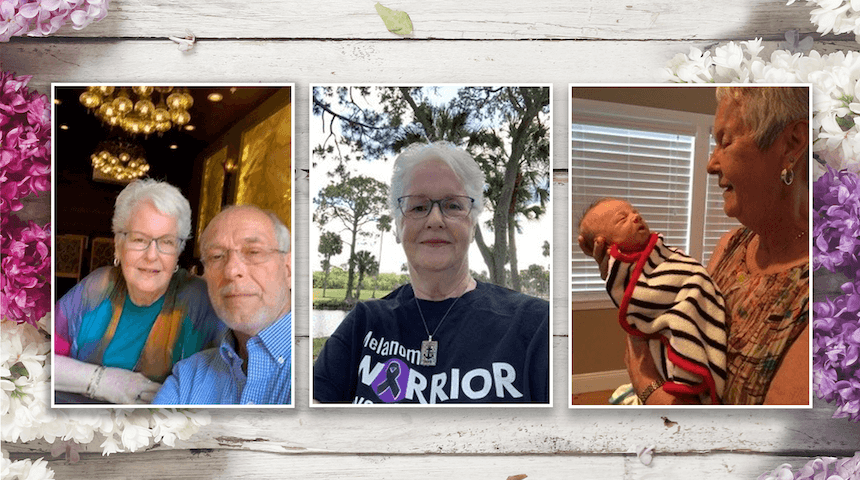‘I Can Do Anything I Want To Do.’ Deep Brain Stimulation Ends Decades of Tremors
By Elizabeth Katona, Editorial Contributor
One evening at dinner with friends, Sue Lareau noticed her hand shaking as she reached for her water glass.
After completing motor tests, she was diagnosed with essential tremor. She was only 34, but in a way, that was a relief.
“I was nervous that I may have Parkinson’s,” Lareau said.
She thought she could learn to live with the condition. And for decades, she did.
“From ages 34 to 65, I adapted to these tremors and thought I could handle this,” said Lareau, who is now 67.
Lareau, who was a teacher, said in the last two years before she retired, the tremors had become so intense that she knew something had to be done.
“I couldn’t type on a keyboard,” she said. “Holding food on a fork or spoon wasn’t possible. I couldn’t cut food. I couldn’t put on jewelry anymore. Carrying things in both hands wasn’t possible.”
A Michigan native, Lareau moved to Vero Beach, Florida, and she began seeing a neurologist to help manage her tremor. She had been on medication for a while, and it worked throughout the years. But as her tremor worsened, she had to keep increasing the dose of the medication. She finally got to the point where she couldn’t increase the dose anymore. But, the tremor continued to become more severe.
“It was just limiting,” she said. “I didn’t realize all the things I had given up over the years.”
Understanding Essential Tremor

Lareau’s neurologist in Vero Beach suggested that Lareau see Dr. Mariel Szapiel, a board-certified neurosurgeon and director of functional neurosurgery at Orlando Health Neuroscience Institute.
“Essential tremor is a neurodegenerative disorder, and it’s one of the most common movement disorders,” Dr. Szapiel said. “We don’t know why they have the tremor, but we know that there is dysregulation and abnormality in the movement network. It’s more common in upper extremities, but it can also affect the legs, voice, head and neck.”
Essential tremor affects about 10 million people in the United States, and Dr. Szapiel says more than half of cases are inherited. In fact, Lareau seems to be among those cases. She said several of her family members have essential tremor.
Dr. Szapiel said that in addition to functional complications from essential tremor, like the inability to hold items without shaking, it can also affect sufferers socially and professionally.
Lareau echoed that sentiment.
“I would try not to be self-conscious in public, but it’s hard not to be,” Sue said. “You’re a master at hiding your hands. Your hands are what people notice.”
Like a Brain Pacemaker
After consulting with Dr. Szapiel and discussing with her husband, Lareau decided to proceed with deep brain stimulation, or DBS. Dr. Szapiel said all essential tremor patients are treated with medications, but it’s common for the medicine not to work. When that happens, the other option is electricity. This is where DBS comes in.
“It’s like a brain pacemaker,” she said. “It requires a small wire to be inserted deep in the brain. To safely get there, we do a stereotactic brain MRI, which is like Google maps for the brain.”
Dr. Szapiel, who has completed more than 500 DBS procedures, said it’s crucial not to touch sensitive areas or hit a blood vessel during the procedure. The target area is less than a centimeter, so Dr. Szapiel makes a small incision in the scalp and creates a hole about the size of a dime in the skull.
DBS is divided in two steps. First, an electrode is put in, and the patient is awake so Dr. Szapiel can record brain signals. This takes 45 to 90 minutes, and the patient stays one night in the hospital. Four to six weeks after surgery, the patient will then have an outpatient visit to have the battery inserted in the chest.
I couldn’t type on a keyboard. Holding food on a fork or spoon wasn’t possible. I couldn’t cut food. I couldn’t put on jewelry anymore. – Sue Lareau
The battery is connected via a small wire up to the electrodes in the brain, and the patient can adjust its frequencies if they do experience any tremors to help movement get back on track. Batteries come in rechargeable and nonrechargeable options and can last for several years.
“I want to make sure patients understand the possibilities, as it takes patient involvement and commitment,” Dr. Szapiel said. “I do reassure them that if we recommend the surgery, it’s because we know it’s going to help. We’re expecting 50 percent or better improvement.”
Lareau had her procedure this year in both sides of the brain. She had her left side done in March and then the right side done in June. She noticed a change right away, and when she received breakfast in the hospital after the procedure, her husband was amazed that she could pick up a full glass of orange juice.
“He had never known me to be able to do that,” she said.
In plain sight
One of the most studied procedures, DBS was approved by the Food and Drug Administration in 1997.
“This is not a research procedure,” Dr. Szapiel said. “For people who work in the field, it’s bread and butter. It has a really good safety profile, and patients also go under psychological evaluation to avoid cognitive complications. It’s elective, so the safety is very scrutinized.”
The procedure, which is also used to treat conditions such as Parkinson’s disease and epilepsy, has been around for decades, but many people are unaware of it and capacity to improve tremor symptoms of over 85%, according to studies. Dr. Szapiel wants to change that.
“A lot of patients are told to live with essential tremor,” Dr. Szapiel said. “They don’t know this exists, and they have lived with the tremor for decades. I can’t tell you how many times I’ve had a patient cry because they can’t believe what they’re seeing. They’re crying because they’re happy. It’s a remarkable and life-changing experience.”
Lareau is enjoying life without tremors.
“My quality of life is totally back. I can do anything that I want to do. I can write. I can eat. I can brush my hair. It sounds silly, but I can drink without a straw,” she said.
In fact, she recently sewed a Christmas stocking for her granddaughter – something she would have never been able to do before.
“I’m totally under control now,” Lareau said. “I’m tremor-free.”









